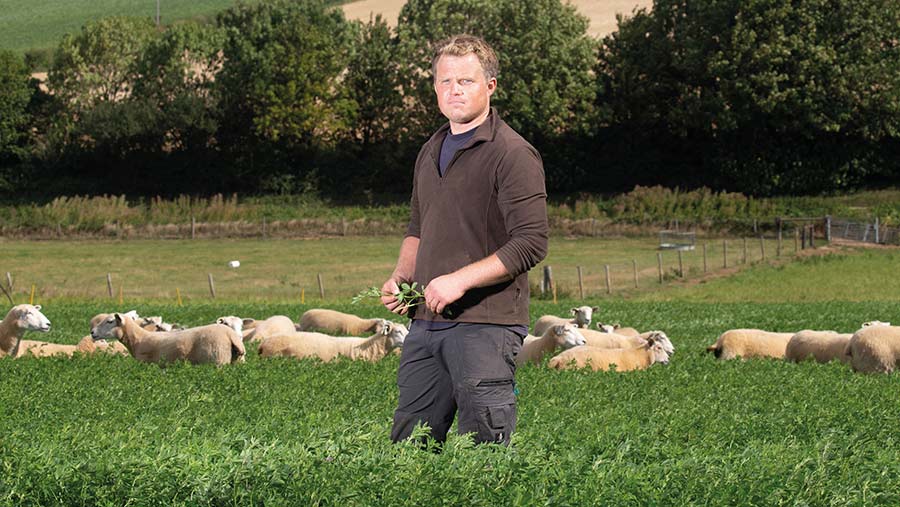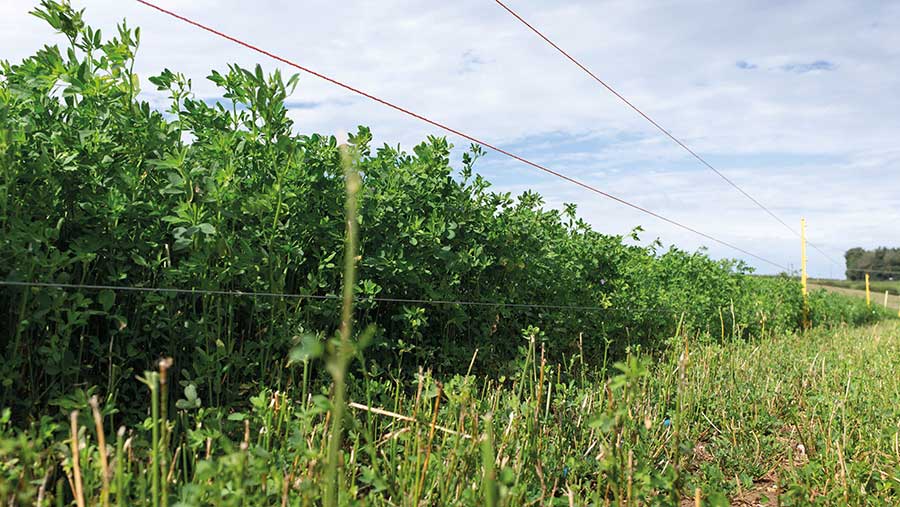What to consider when growing lucerne to graze sheep
 David Cross © Tim Scrivener
David Cross © Tim Scrivener David Cross set up an Innovative Farmers field lab to look at the practicalities of grazing his sheep on lucerne on his north Norfolk farm.
He wanted to see if the crop could help in managing dry summers on the farm’s light soils, and to find which system worked best.
The first year of the trial looked at the performance of twin-bearing ewe lambs and mixed-aged ewes on lucerne and a ryegrass and clover mix.
Lucerne showed strong and consistent growth through the drought conditions of May and June, while the grass burnt off. But growth rates of lambs in the two groups were very similar.
See also: How lucerne could help bridge summer forage gap
This year, lucerne was compared to a range of mixes with a wider range of species:
- Two Field Options mixes: Lamb Ultra plus herbs and Endurance II Herbal
- Germinal Dryland two-to-three-year grazing mix
- GS4 Countryside Stewardship mix
The aim was to compare lucerne with swards more representative of those being grown at Glovers Farm.
Ewes with the biggest demand – mixed-aged ewes with triplets and twin-bearing ewe lambs – were spread across the four mixes.
Farm facts: Glovers Farm, Sedgeford, Norfolk
- 360ha (890 acres) tenanted land on Sedgeford Hall Estate
- Mainly light, alkaline soils over chalk (susceptible to summer drought)
- Mid Tier Countryside Stewardship scheme including 57ha (140 acres) GS4 legume- and herb-rich swards in arable rotation
- Arable rotation of barley, wheat, potatoes, sugar beet and grass leys
- 40ha (99 acres) permanent grassland
- 900 Texel cross Romney and Easydam ewes tupped by EasyRams
- New beef and arable monitor farm as part of AHDB’s Farm Excellence project
Results
Lambs grew faster and ewes maintained better condition on lucerne than the other mixes (see table below).
The Field Options and the Germinal mixes also showed good growth rates. However, there were extra single-bearing ewes on the Germinal mix, which inflated the liveweight gain for that group.
The GS4 mix produced the lowest rates of liveweight gain, reflecting the fact that research into animal performance on GS4 has tended to focus on cattle rather than sheep, says Liz Genever, independent sheep consultant and lead researcher and facilitator for the field lab trial.
“We don’t really know what lamb performance is like on some of the grasses in this mix when they are grown together because most work on GS4 has been with cattle,” she says.
Sheep grazing the GS4 were also moved less frequently – every five days, compared with every three on the other mixes – to build up sufficient rest periods between grazing. This may also have affected the results.
Farmer view
“This year has been very different to last; there’s been a marginal increase in lucerne production, but everything else has done better, too,” says Mr Cross, who was keen to use the field lab to build on his experience of seeing lucerne grown on a study trip to New Zealand.
A mild spring encouraged lots of growth, but a late, sharp frost knocked the top 15cm off the lucerne – something he hadn’t factored in.
Mr Cross had been warned about the risk of bloat and red gut when grazing lucerne, but the problem with photosensitivity experienced in 2020, where high nitrate levels in the lucerne leaf led to sheep losing wool and suffering sunburn, came as a surprise.
He has overcome the problem this season by weaning lambs earlier, at 70 days instead of 95-105.
“The lambs grow like hell on lucerne, but our experience over the past two years is that growth starts to tail off and becomes very inconsistent – some will be at 400g/day, and some will be going backwards.
“It may be that some animals are not fully suited to lucerne and, long term, we would have to select for sheep that do well on it.”

Lucerne crop © Tim Scrivener
Future
Growing lucerne as part of an arable rotation is tricky, says Mr Cross, because it persists for several years.
While this is a strength of the crop in some settings, it would mean extending the arable rotation at Glovers Farm, and that is not considered practical.
Instead, the farm’s mixed swards of grass, clover, chicory and plantain are being phased out in favour of more diverse mixes grown as part of a new Mid-Tier Countryside Stewardship (CS) agreement.
GS4 legume- and herb-rich swards are being established on 57ha (140 acres), while continuing with the wild bird food and pollen and nectar mixes, supplementary winter bird feed and grass margins managed under the farm’s previous scheme.
At £309/ha, adding GS4 to the scheme has more than compensated for the drop in BPS this year, he says.
However, the two-year trial has shown that lucerne does have a place in feeding priority stock: ewes with triplets, ewe lambs with twins and late-lambing ewes.
Rather than being grown as a pure stand, the next crop sown – an additional 17ha (42 acres) – will be a mix of 11kg lucerne, 2kg plantain and 2.5kg Timothy.
Without the banned herbicide 2,4-DB to control broadleaved weeds, Mr Cross, guided by the experience of other growers, hopes this mix of species will be easier to manage.
“In a dry year, annual weeds can’t compete with lucerne because there is no surface moisture, but this year annual meadow grass, brome and so on have crept in.
So, if [those gaps in the sward] were filled with Timothy, it might work better, as well as providing better ground cover for lambing on.
“The other species will also help buffer instead of having to feed fibre such as hay, and a bit of mowing to wilt the crop a little [before grazing] will improve gut health and reduce the risk of photosensitivity.”
David Cross’s top tips for managing lucerne for grazing
- Lucerne is good for maintaining body condition score of ewes and producing reasonable growth rates, so prioritise high demand animals, such as triplet-bearing ewes or ewe lambs bearing twins, that might otherwise struggle
- Give the crop an autumn rest of 40 days
- Wean lambs earlier
- Remember basic health needs – haylage, hay or good barley straw as roughage, and ad-lib salts
- Try not to stay on the same field for longer than four or five days so the sheep don’t graze any regrowth
Results from year two of the lucerne field lab at Glovers Farm |
||||
|
|
Field option mixes |
Lucerne |
Germinal Dryland mix |
GS4 |
|
Liveweight gain (g/day) |
305 |
318 |
310 |
250 |
|
Ewe body condition score at weaning |
3.0 |
3.75 |
3.5 |
2.8 |
|
Average age at weaning (days) |
95 |
85 |
105 |
90 |
|
Stocking rate (ewes a hectare [ewes an acre]) |
10.6 (4.3) |
15.6 (6.3) |
14.3 (5.8) |
9.9 (4) |
|
Production* (kg lamb liveweight/ha) |
450 |
865 |
767 |
407 |
|
*(liveweight gain x age at weaning) x number of lambs divided by hectares allocated |
||||
